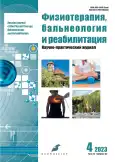Effectiveness of complex therapy uncomplicated chronic pelvic pain syndrome
- Authors: Sozaewa L.G.1, Evstigneeva I.S.1, Romanovskaya O.A.2
-
Affiliations:
- Russian Medical Academy of Continuous Professional Education
- S.P. Botkin City Clinical Hospital
- Issue: Vol 22, No 4 (2023)
- Pages: 281-290
- Section: Original studies
- URL: https://journals.rcsi.science/1681-3456/article/view/255379
- DOI: https://doi.org/10.17816/rjpbr627503
- ID: 255379
Cite item
Abstract
BACKGROUND: Therapeutic measures for chronic pelvic pain are of a pronounced interdisciplinary nature and consist of a complex of various means of influence: pharmacotherapy, physiotherapy and psychotherapy, physical therapy, surgical treatment. The solution to problems is usually achieved by prescribing venotonic drugs of systemic action, which increase venous tone, normalize capillary permeability and resistance, improve the rheological properties of blood, and for the same purpose use antihomotoxic drugs of plant origin. In addition, physiotherapy methods have become widespread in the treatment of patients with pelvic pain syndrome. Currently, pulsed magnetic therapy technologies have been developed in detail, but we hypothesized that the combined use of extracorporeal magnetic stimulation of the pelvic organs and the use of local regeneration cream can ensure mutual enhancement of the effectiveness of therapeutic effects.
AIM: To study the clinical effectiveness and characteristics of vascular reactions in response to combined treatment of pelvic pain syndrome with herbal preparations and extracorporeal magnetic stimulation of the pelvic floor.
MATERIALS AND METНODS: A randomized placebo-controlled study was conducted in 91 patients with chronic pelvic pain (more than 6 months in history). The patients were divided into 3 groups and did not differ significantly in the main studied parameters (age, parity, menstrual function, severity and duration of pain). The 1st group (n=30) patients independently carried out daily monotherapy with a cream stick of plant origin ― rectally, the 2nd group group (n=31) included women who, from the 5th to the 15th day of the menstrual cycle, had a menstrual cycle for 10 days procedures for extracorporeal magnetic stimulation of the neuromuscular apparatus of the pelvic floor; after completing the course of physiotherapy, a herbal preparation of rectal origin was prescribed daily; group 3 (n=30) included female patients who underwent physiotherapy procedures.
RESULTS: It was found that patients suffering from chronic pelvic pain need to undergo complex treatment, including physiotherapy techniques and rectal preparations of herbal origin. In groups receiving combination therapy for chronic pelvic pain, a long-term clinical effect was obtained; these data correlate with ultrasound parameters.
CONCLUSION: It has been established that women suffering from chronic pelvic pain should undergo a comprehensive treatment including physiotherapy techniques, in particular extracorporeal magnetic stimulation of the pelvic organs, and rectal preparations of herbal origin.
Full Text
##article.viewOnOriginalSite##About the authors
Larisa G. Sozaewa
Russian Medical Academy of Continuous Professional Education
Email: sozaewa@mail.ru
ORCID iD: 0000-0002-1793-5684
SPIN-code: 5452-8168
MD, Cand. Sci. (Med.), Associate Professor
Russian Federation, MoscowInna S. Evstigneeva
Russian Medical Academy of Continuous Professional Education
Author for correspondence.
Email: evstigneevais@mail.ru
ORCID iD: 0000-0001-9128-0965
SPIN-code: 5163-7726
MD, Cand. Sci. (Med.), Associate Professor
Russian Federation, MoscowOlga A. Romanovskaya
S.P. Botkin City Clinical Hospital
Email: romanovskaya.oa@yandex.ru
ORCID iD: 0000-0001-9429-6102
SPIN-code: 6356-0638
Russian Federation, Moscow
References
- Endometriosis. Clinical recommendations. Moscow; 2020. 182 р. (In Russ).
- Gynaecology: National guide. Ed. by G.M. Savelieva, G.T. Sukhikh, V.N. Serova, et al. Moscow: GEOTAR-Media; 2017. Р. 417–429. (In Russ).
- Orazov MR, Radzinsky VE, Dolgov ED. Chronic pelvic pain in endometriosis: from therapeutic abstraction to clinical definition. A review. Gynecology. 2023;25(3):308–313. EDN: QCZSMT doi: 10.26442/20795696.2023.3.202290
- Borisova LI, Ibragimova AR, Ivanova TV, et al. Problems of chronic pelvic pain in modern gynecology. Russ Bulletin Obstetrician Gynecologist. 2023;23(5):56–60. EDN: FGJBFI doi: 10.17116/rosakush20232305156
- Shmonin AA, Maltseva MN, Melnikova EV, Ivanova GE. Issues of compliance with drug treatment in medical rehabilitation. Doctor.Ru. 2017;(11):19–26. EDN: ZRXNAB
- Yan Y, Dou C, Wang X, et al. Combination of tomographic ultrasound imaging and three-dimensional magnetic resonance imaging-based model to diagnose postpartum levator avulsion. Sci Rep. 2017;7(1):11235. doi: 10.1038/s41598-017-08201-9
- Orazov MR, Silantyeva ES, Soldatskaya RA, et al. The efficacy of physical therapy in treatment of pelvic floor distress in women of reproductive age. Doctor.Ru. 2020;19(8):71–76. EDN: GHMONP doi: 10.31550/1727-2378-2020-19-8-71-76
- Radzimińska A, Strączyńska A, Weber-Rajek M, et al. The impact of pelvic floor muscle training on the quality of life of women with urinary incontinence: A systematic literature review. Clin Interv Aging. 2018;(13):957–965. doi: 10.2147/CIA.S160057
- Pushkar DY, Kulikov AG, Kasyan GR, et al. Extracorporeal magnetic stimulation of the neuromuscular apparatus of the pelvic floor in urological practice. Russi J Physical Ther Balneother Rehab. 2019;18(4):264–267. EDN: BZBKOT doi: 10.17816/1681-3456-2019-18-4-264-276
- Ismail SI, Forward G, Bastin L, et al. Extracorporeal magnetic energy simulation of pelvic floor muscles for urodinamic stress incontinence of urine in women. J Obstat Gynaecol. 2009;29(1)35–39. doi: 10.1080/01443610802484393
Supplementary files










